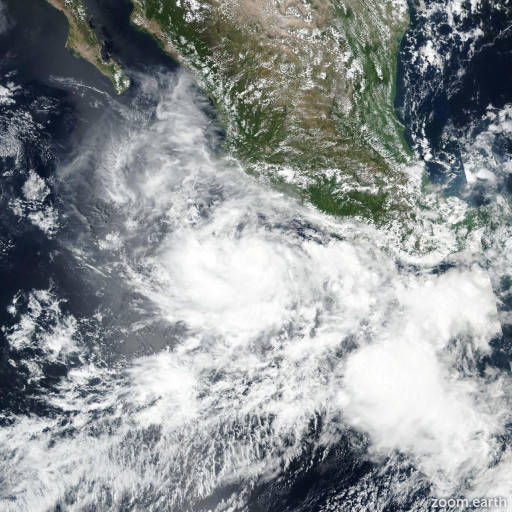Hurricane Narda 2025
Last Modified:

Live tracking map, satellite images and forecasts of Hurricane Narda 2025 southwest of Mexico. Current wind speed 105mph. Max 110mph.
The recent convective structure of Narda is characterized by a CDO containing cold cloud tops colder than -80°C, with a curved band also noted to the west of the CDO. SHIPS guidance and UW-CIMSS are currently analyzing 20–25 knots of east-northeasterly shear. This shear has prevented any strengthening over the past 6 hours. In fact, the structure appears somewhat less impressive on a recent 24/11:21 UTC F18 SSMIS microwave overpass. Given that the latest TAFB and SAB fixes are both T5.0/90 knots, the 90-knots intensity from the previous NHC advisory will be held for this advisory.
Narda's motion hasn't changed, still estimated to be westward, or 265 degrees at 15 mph (11 knots). A general westward motion will continue over the next 36 hours, followed by a gradual turn to the west-northwest as the cyclone is steered by a mid-level ridge to its north. A mid-level low over central California is likely to sink southward toward northern Baja California by Friday night, which will act to erode the ridge. This should cause Narda to turn rather sharply toward the north by Saturday, along with a decrease in forward speed. The official forecast is similar to the previous advisory for the first couple of days, but lies a bit to the left, or west, of the previous NHC advisory at days 3–5. The official forecast is closest to the TVCE and GFEX during that period, which lie in between the eastern HCCA solution and the western Google Deep Mind solution.
The aforementioned strong northeasterly vertical wind shear is expected to continue through tonight, then decrease to moderate magnitudes by Thursday while Narda remains over warm sea-surface temperatures and within a moist environment. The NHC forecast will continue to call for some weakening through tonight, followed by some restrengthening by Thursday night and into Friday. Narda is forecast to move into cooler waters and cross the 26°C sea-surface temperature isotherm by Saturday while reaching a somewhat drier environment around the same time. The NHC forecast shows rapid weakening during that time.
It should be noted that there is a healthy amount of model spread beyond Day 3 as to how quickly Narda gains latitude during the 3–5 day period. These track differences could also affect the intensity forecast (how quickly Narda weakens during that time period).